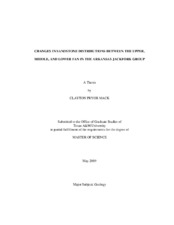CHANGES IN SANDSTONE DISTRIBUTIONS BETWEEN THE UPPER, MIDDLE, AND LOWER FAN IN THE ARKANSAS JACKFORK GROUP
Abstract
This study is a statistical analysis of the sandstone distribution within the
Arkansas Jackfork Group which is a passive margin fan complex. Passive margin fan
systems are typically associated with long fluvial transport, fed by deltas, wide shelf,
efficient basin transport, that result in a bypassing system. Passive margin fans are
generally fine-grained, mud rich, and well sorted. These fans can be separated into three
units (upper, middle, and lower fan) based on their location within the fan and how the
sediments are deposited. Five outcrops from the Arkansas Jackfork Group have been
chosen for this study and each were divided into different facies dependent on sandstone
percentages in certain bed sets. The amount of sandstone for each facies was calculated
and a statistical approximation for each outcrop was determined. Sandstone distribution
curves were made for each outcrop to show a graphic representation of how the
sandstone is dispersed.
After analyzing different upper, middle, and lower fan outcrops, it is clear there
is an obvious change in the sandstone percentage and distribution. The upper fan deposit
has an overall sandstone percentage of approximately 77.5% and is deposited in beds that are mainly amalgamated; 10-30m thick. Sandstone is deposited moderately even
and is quite concentrated throughout the exposure. The middle fan outcrops contain
approximately 72.6% sandstone and show similar patterns, except that the amalgamated
sandstone beds are not as thick, 5-15m and contain more shale in between layers. As
expected the lower fan outcrop is completely different in both sandstone percentage and
distribution. The lower fan has approximately 65.4% sandstone. The distribution of
sandstone is more concentrated in each of the individual units, or systems, but the
overall complex has two systems separated by a massive marine shale bed, 33.5 m, that
contains virtually no sand.
Citation
Mack, Clayton P. (2009). CHANGES IN SANDSTONE DISTRIBUTIONS BETWEEN THE UPPER, MIDDLE, AND LOWER FAN IN THE ARKANSAS JACKFORK GROUP. Master's thesis, Texas A&M University. Available electronically from https : / /hdl .handle .net /1969 .1 /ETD -TAMU -2009 -05 -272.


